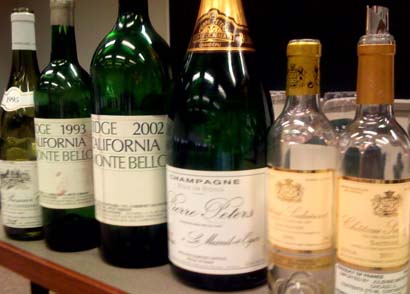Dr Vino's wine blog
wine talk that goes down easy
Better wine through science!
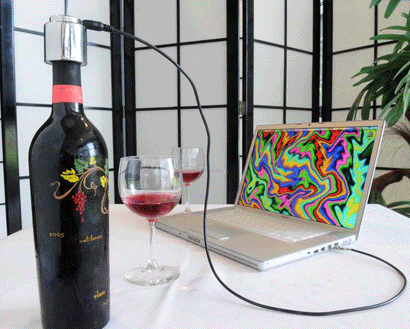
Researchers at the Argonne National Laboratory have taken a break from their usual physics research and turned their attention to combating wine fraud.
Roger Johnston and Jon Warner in Argonne ‘s Vulnerability Assessment Team have developed a cap that can be put in place at the winery to track if the bottle has ever been opened or tampered with.
However, if you thought resistance to screwcaps was high in the realm of fine wine, get a load of this Lojac meets Denver Boot meets car alarm thingy. And just look how it makes your laptop bug out when you connect the two! Full details on the story in their press release. (hat tip: Andrew)
In other wine and technology news circulating today, the e-tongue has resurfaced. But we’ve already wagged our tongues at that one!
Billionaire’s Vinegar by Benjamin Wallace
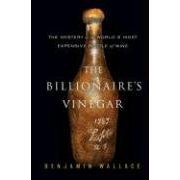 In 1985 at Christie’s auction house in London, Kip Forbes–dispatched by his father Malcolm to bring home a bottle of 1787 Bordeaux on the Forbes private jet–finds surprising competition from a then-upstart publisher: Marvin Shanken of the fledgling Wine Spectator. A spectacular bidding war ensues over the bottle that may have belonged to Thomas Jefferson and one of them takes the bottle back to New York in an extra seat on the plane, strapped to a mattress (read the book to discover which one) after winning it for $156,000.
In 1985 at Christie’s auction house in London, Kip Forbes–dispatched by his father Malcolm to bring home a bottle of 1787 Bordeaux on the Forbes private jet–finds surprising competition from a then-upstart publisher: Marvin Shanken of the fledgling Wine Spectator. A spectacular bidding war ensues over the bottle that may have belonged to Thomas Jefferson and one of them takes the bottle back to New York in an extra seat on the plane, strapped to a mattress (read the book to discover which one) after winning it for $156,000.
Such is a great scene near the beginning of the fantastic book Billionaire’s Vinegar: The Mystery of the World’s Most Expensive Bottle of Wine. Released last month, this page-turning book that reads like fiction has already reached the extended NYT bestseller’s list. It’s a wine book that has a lot of appeal beyond simply wine geeks since the book’s verve derives not from tasting notes but a mystery over whether the bottle that Shanken and Forbes bid on was real or fake. Read more…
FT Wine Investment – mature wines and more
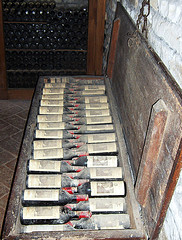 A special section on Wine Investment hits newsstands in today’s Financial Times and the enlightened folks on the other side of the pond have put the full contents online. Huzzah!
A special section on Wine Investment hits newsstands in today’s Financial Times and the enlightened folks on the other side of the pond have put the full contents online. Huzzah!
Even if you aren’t that into wine as an investment, the section offers a lot of bang for the free buck. The lead article by Jancis Robinson is about Hong Kong as an emerging center for wine (as we discussed here with a focus on riesling) and I’d like to return later to some of the other issues raised in other pieces. For now, I thought the round-table with three American collectors, including the “Big Boy,” Rob Rosania (his Salon 1996 strategy we also already discussed), provided a quick observation worth noting.
Older vintages are woefully undervalued is one sentiment that the collectors bring up. I have felt the same way since I bought a beautifully mature 1971 Giacomo Conterno Barolo last year for $300, which is a mere fraction of other collectible wines upon release today.
Raymund Tuppatcsh, one of the collectors in the roundtable, says that’s going to change soon. “I think you are going to see a correction to the upside like you’ve never seen – a tripling or quadrupling of prices over the next 18-24 months.” Yikes. Time to buy more wines from our birth years now?
(image)
Stocking up on Salon 1996
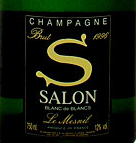 Rob Rosania, a 38 year-old collector aka “Big Boy,” sold off around $5 million of his champagne and still wines at auction a couple of weeks ago. And yet he still remains one of the biggest collectors of champagne around.
Rob Rosania, a 38 year-old collector aka “Big Boy,” sold off around $5 million of his champagne and still wines at auction a couple of weeks ago. And yet he still remains one of the biggest collectors of champagne around.
This factoid from a recent Bloomberg article piqued my interest: Rosania owns 400 cases of the excellent champagne Salon 1996 (minus the five he sold at auction) out of a total of 5,000 produced. Poking around on the web revealed other sources saying that there were 8,000 cases produced. And these are six-bottle cases that we’re talking about. The champagne retails for $250 – $300 (search for the Salon 1996).
It’s a fascinating strategy for investing in wine. Rosania has somewhere between five and eight percent of this blue chip wine outstanding–and that percentage rises every time a cork of it is popped elsewhere. That’s probably a good percentage of the production to have to really benefit from a future price move yet not control the market entirely. It would be hard to take an equivalent percentage of a first growth Bordeaux wine since the production volumes are higher. All it takes is a big cellar and a cool $700k or so.
Even if the economy stagnates, wine such as this will probably always have buyers. Could it double in value in ten years? Even if it doesn’t Rosania can always have fun popping open the bottles of this fine wine with his saber.
I’ve tried a tasting-sized-pour of the 96 Salon and it is a brilliant champagne. In a wine investing video game, I might be tempted to adopt a similar strategy. If, in some fantasy world, you were going to take ten percent of a wine, which would it be?
Will Asian buyers refocus on Riesling?
 Robert Parker goes to China. It doesn’t quite have the same geopolitical impact as Nixon goes to China, but the magnitude for the wine world may be similar as Parker heads there later this month for the first time. Jancis Robinson stopped by earlier this year too. And two big auction houses have resumed wine auctions in Hong Kong this spring after a seven year drought. The removal of the wine tax in Hong Kong has driven a “thirst for top-level wines” in the city “is growing at an exponential rate,” according an auctioneer quoted in Bloomberg.
Robert Parker goes to China. It doesn’t quite have the same geopolitical impact as Nixon goes to China, but the magnitude for the wine world may be similar as Parker heads there later this month for the first time. Jancis Robinson stopped by earlier this year too. And two big auction houses have resumed wine auctions in Hong Kong this spring after a seven year drought. The removal of the wine tax in Hong Kong has driven a “thirst for top-level wines” in the city “is growing at an exponential rate,” according an auctioneer quoted in Bloomberg.
Apparently Asian buyers are getting much more wine savvy. It wasn’t long ago that they only bought wines with 100 point Parker scores, perhaps a sign of slavish following more than connoisseurship.
But now I am wondering if the locals are waking up to the joys of pairing Riesling with the cuisine. And the quality of German Riesling just keeps getting better and better. Perhaps they now have confidence to venture away from Bordeaux and cult Cali cabs.
Actually, since I am really getting into the sublime pleasure of German Riesling, dry and off-dry, young and mature, the thought of demand from Asia is something of a doomsday scenario for me. The last thing I need is to have investors pile in and run up the price in yet another category of wine!
Hammer time! The auction fraud story heats up
 The pace of events in the best wine story of the year has just quickened. Earlier in the year, the Wall Street Journal had a page one story revealing the billionaire Bill Koch had assembled evidence of fraud in the auction market and was preparing to turn it over to the FBI. The New Yorker followed with a fascinating story of “The Jefferson Bottles,” which laid out even more details about the story, which included such characters as Koch, described as a billionaire sheriff trying to right wrongs, an elder statesman in the world of auctions who was either culpable or gullible, and a fraudster named Hardy Rodenstock who was known fro throwing elaborate parties and perhaps being a superb blender of old wines into fraudulent bottles.
The pace of events in the best wine story of the year has just quickened. Earlier in the year, the Wall Street Journal had a page one story revealing the billionaire Bill Koch had assembled evidence of fraud in the auction market and was preparing to turn it over to the FBI. The New Yorker followed with a fascinating story of “The Jefferson Bottles,” which laid out even more details about the story, which included such characters as Koch, described as a billionaire sheriff trying to right wrongs, an elder statesman in the world of auctions who was either culpable or gullible, and a fraudster named Hardy Rodenstock who was known fro throwing elaborate parties and perhaps being a superb blender of old wines into fraudulent bottles.
Now, the WSJ goes back to the well and reported on p. A16 on yesterday that Bill Koch has sued Zachys and collector Eric Greenberg in federal court in New York. Koch bought $3.7 million from a Zachys auction on October 28, 2005 that was sourced to Greenberg’s cellar and now alleges that 11 of those bottles were fakes. Zachys declined to comment and Greenberg’s attorney called the allegations “absolutely false.”
But now Howard “wine under $20” Goldberg rides in with the revelation on Decanter.com that it was Eric Greenberg’s cellar that was auctioned this past weekend by Acker, Merrall. Acker had previously not named the collector who was selling, instead referring to it as “the man with the golden cellar.” It fetched $15.6 million including commissions.
Related: “Has the wine auction market peaked?” [Dr. V]
See the official court papers via scribd.com
Can Chilean wines age? A Montes challenge
Just over thirty years ago, Chilean wines entered the world wine stage. As with the export trajectory of Japanese car manufacturers, Chilean wine makers started by exporting inexpensive but reliable offerings. And as with the Japanese car manufacturers, they eventually became so proficient at the low end that they began to target the high end and focus on quality.
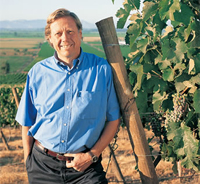 Montes is one of the more recent quality producers, more Lexus than Toyota (although they do have reliable wines at $10). Started in 1987 as a partnership between Aurelio Montes and Douglas Murray, the company now makes wines in Argentina under the Kaiken brand and in Napa, from Rutherford and Coombsville, to be released in 2008.
Montes is one of the more recent quality producers, more Lexus than Toyota (although they do have reliable wines at $10). Started in 1987 as a partnership between Aurelio Montes and Douglas Murray, the company now makes wines in Argentina under the Kaiken brand and in Napa, from Rutherford and Coombsville, to be released in 2008.
At a recent tasting in New York City with Aurelio Montes, a key question for me was: can Chilean wines age? With eight vintages of the Alpha M (a cabernet-dominant blend, generally about $80 retail) in front of me dating back to 1997, I tasted through to find the answer to be yes but the record is short and mixed. I also found out about the mysterious phenomenon of the “annual rhythm.” Read more…
Magnums, what are they good for, Terry Theise?
Is bigger better?
This perennial question came up during my class on Saturday at the University of Chicago. In this context, it related to bottle size, specifically, magnums.
The tasting had two magnums, one of Pierre Peters, “cuvee de reserve” Champagne and another of Ridge Monte Bello 2002. How sweet it is to organize tastings!
Anticipating the question of size, um, arising, I asked none other than the importer of the champagne, Terry Theise, via email beforehand. Here is his reply (reproduced with permission): Read more…
